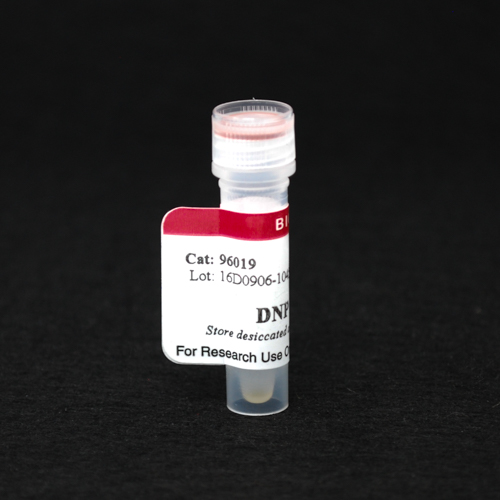DNP Tyramide
DNP (dinitrophenol) tyramide conjugate can be used for tyramide signal amplification (TSA), an horseradish peroxidase (HRP)-catalyzed high-density staining method for increasing immunofluorescence sensitivity.
Please fill in the inquiry form and we will contact you shortly.
Wishlist updated! View wishlist
Product Description
DNP (dinitrophenol) tyramide can be used for used for tyramide signal amplification (TSA), a method for high-density labeling of a target protein or nucleic acid with DNP.
- High-density labeling of a target protein or nucleic acid for enhanced detection sensitivity
- Especially suited for the detection of low abundance targets
- Detection sensitivity of over 100-fold compared to conventional procedures
DNP is a hapten tag that can be detected using an anti-DNP antibody. We also offer other TSA reagents including CF® dye tyramides, Ready-to-Use Tyramide Amplification Buffer, Tyramide Amplification Buffer Plus (an improved formulation for enhanced TSA sensitivity), and CF® Dye Tyramide Amplification Kits.
Learn more about Tyramide Signal Amplification.
Tyramide Signal Amplification
TSA is a highly sensitive method for differential gene or protein analysis or detection of low-abundance targets, in fluorescent ICC, IHC, and FISH applications. An antibody- or streptavidin-HRP conjugate catalyzes the deposition of fluorescent dye/biotin/DNP tyramides on tyrosine residues on and adjacent to a target protein or nucleic acid sequence in situ. This results in high-density labeling of the target and significantly improves the detection sensitivity up to 100-fold compared to conventional methods. TSA is particularly advantageous for fluorescence detection in human tissue, where conventional ICC or FISH often fails to provide adequate signal over autofluorescence background. In applications where increased sensitivity is not required, TSA enables the use of significantly lower antibody or probe concentrations for the same level of detection sensitivity thereby reducing issues of non-specific binding or cross-reactivity. Furthermore, since binding of the tyramide label is covalent, a large number of targets can be detected in the same sample using multiple rounds of sequential TSA, in which the availability of antibodies from different host species is not a limitation. TSA also can be easily integrated with conventional immunostaining. Learn more about Tyramide Signal Amplification.

